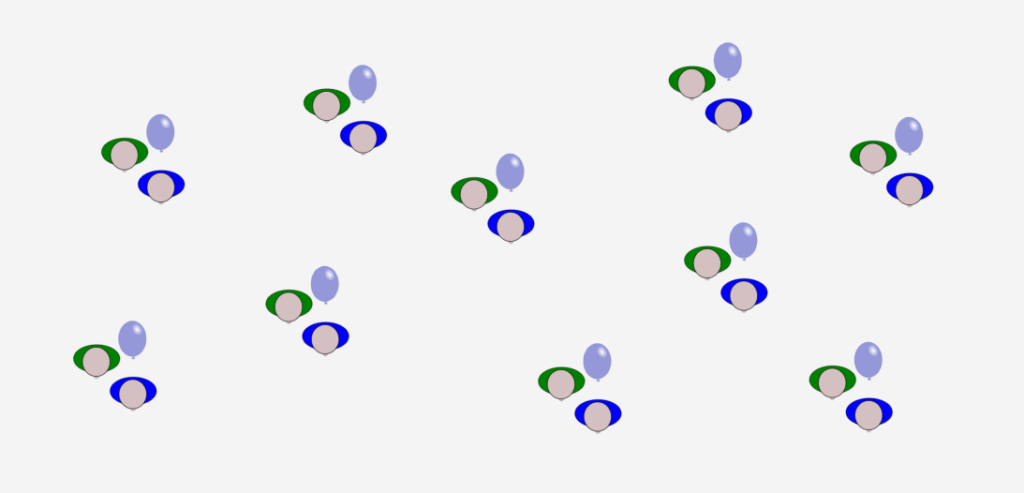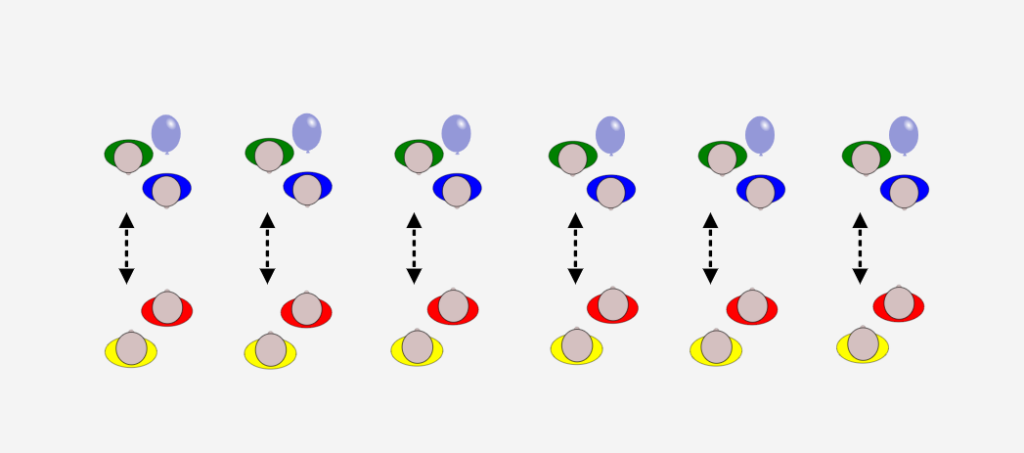EXPLANATION OF THE ROUTINE
In this video you will see an exercise routine with a default level, variations and a level up that combines different variations. The routine can be incorporated as a warm-up or as part of the PE curriculum. It consists of various basic movement skills, such as jumping, running, change of direction, smashing, catching, etc.
PREPARATION
Besides blowing up the balloons, no specific preparations are necessary. Children will execute the exercise routine in pairs, spread over the gym with enough space in between the pairs. For the variations different available materials can be used.
EXECUTION OF THE ROUTINE
See default level and level up
ADDITIONAL INFORMATION: HOW DO WE REACH OPTIMAL MOTOR LEARNING AND APPLY SELF-DETERMINATION?
- Implicit motor learning: This is stimulated with the external focus / analogy examples of instructions/feedback to improve body posture while jumping and landing.
- Challenge/Fun: Getting the balloon on time, especially in the level up is a challenging element of the routine. This also creates the unanticipated moves. The transfer from landing towards running to the balloon is unanticipated since this is dependent of the trajectory of the balloon. Where the child needs to crawl under the bridge and then needs to orientate and stand up in function of the balloon and for the child who plays the bridge there will also be unanticipated movements, since the other child will lean on the bridge while jumping. So the bridge needs to anticipate on external forces in order to be stable. Furthermore, winning points (based on difficulty level or optimal movement execution (optimal vs. suboptimal)) can be collected to make it more fun. Picking your own material also makes it fun.
- Motivation: Enhanced by providing autonomy to choose the level of exercise to practice and materials to practice with. Furthermore, exercises will be done together to make it more fun. Enhanced expectancies: different difficulty levels between and within exercises.
- Autonomy: Make the children choose or control different aspect of the play (e.g. buddy and material to practice with and level of exercise).
- Competence: Feeling of competence is created by giving the child option to choose a variation of the exercise (by means of level or material). Let the child pick the version of the routine s/he feels most comfortable with to complete successfully. Also, positive feedback from teacher confirming good trials well boost feelings of competence.
- Relatedness: Feeling of relatedness is created by practicing with and helping peers.
- Differentiation (age/difficulty): The routine is made in order to be easily adapted by the PE teacher for various children’s‘
POSSIBLE VARIATIONS
- Different types of jumps (e.g. side jump, with(out) leaning on the bridge, one leg, frontal jumps,…) over the bridge (can be specified by different whistle signals of the teacher).
- Rolling over or crawling under the bridge.
- Competition between the teams.
- Working together between the teams by smashing/throwing the balloon/ball to each other.
- Bench/box instead of child to jump over: variation in height and angle of the bridge.
- Visual stimuli on the floor to jump in.
- Unstable surfaces for the jump/landing and for the bridge: mat, ball,…
- Passing ball between groups, ball is faster = more adaptive motor control.
- Game element by jumping as most times back and forth within a certain time period..
- Color codes for different variations.
- Adaptation to soccer and basketball (linking): passing football, throwing basketball,…
- Tasks can be defined by a group/child.
- Bridge needs to do push ups.
- Make ‘moving optimally’ a game. That means children can get points by landing correctly (in terms of landing technique for the prevention goal – coach will observe).
The exercise is executed in pairs. Child 1 forms a bridge and holds this bridge until the end of the exercise. Child 2 hits a balloon as high as possible. Then places his hands on the bridge and jumps back and forth over the bridge for 2 times. Finally, child 2 tries to catch the balloon before it touches the ground.
In an even more advanced setting a combination of different variations can be executed and this in collaboration with another team. Instead of hitting the balloon as high as possible, the balloon is smashed towards the other team. After hitting the balloon, the child jumps back and forth over the bridge, while the other team smashes the balloon back and performs their routine. The goal is to smash the balloon back and forth for x-number of times.


